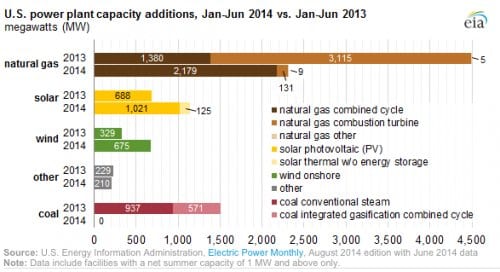Natural gas and solar are the winners so far in 2014 in the race to move electric power generation away from coal, a new U.S. Energy Information Administration report shows.
As utilities across the U.S. have added new electric power generating capacity, most of that added capacity has come from natural gas and solar. No new coal power-generating capacity has been added yet in 2014, though two small plants are expected to open this year in North Dakota and Mississippi.
 The last year in which there were no additions to coal power generating capacity in the U.S. was 1998, according to EIA data.
The last year in which there were no additions to coal power generating capacity in the U.S. was 1998, according to EIA data.
The dearth of interest in opening new coal-fired power plants comes from increased competition from natural gas as a fuel for electric power plants andpending emissions regulationsthat would limit mercury, toxic metals, acid gas and other toxic air emissions from coal-fired power plants.
The U.S. Environmental Protection Agency is also in the process of writing a new regulation that would limit CO2 emissions from existing coal-fired power plants. Called the Clean Power Plan, the regulation would set CO2 emissions reductions goals for power plants in each state.
New natural gas-fueled power generators are quickly coming online across the country as the U.S. continues its move away from coal.
Natural gas produced from the U.S. fracking boom is fueling many new power plants nationwide, and it is often seen as a more climate-friendly alternative to coal-fired power plants because it emits relatively little carbon dioxide. Natural gas distribution systems, however, leak methane, a powerful greenhouse gas.
The U.S. added nearly 2,200 megawatts of natural gas power generating capacity in the first six months of 2014, up 60 percent over the same period in 2013, according to the EIA report.
Solar is growing fast, too, as more than 1,100 megawatts of new solar power generating capacity came online in the first six months of 2014, up 70 percent over the same period last year.
New wind power capacity grew less than half as much as solar early this year. Wind farms added 675 megawatts of wind power capacity in that time, all from new wind turbines built in California, Nebraska, Michigan and Minnesota.
Source: Climate Central. Reproduced with permission.







